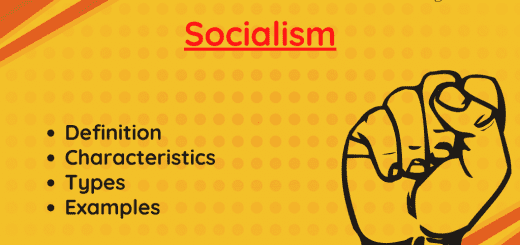Communism – Definition, Characteristics, Types, Examples
Definition of Communism
Communism emphasizes that all wealth and assets are owned by the common public, rather than by individuals. This ideology focuses on replacing profit-based businesses and private property ownership with communal business control and public property ownership (e.g., transportation, power, energy, mines, mills, and production plants) including natural resources.
Communism is an ideology that believes the means of production in a society should belong to the common public via state/government administration. Its focus is on society with economic equality between the entire common public. With communism, there will be differences between the working class and the rich societies. This concept believes that the way to achieve this is by public ownership of the production control, rather than individual ownership.
The idea of communism is based on the ideas of Karl Marx. Communism contains the ideology of socialism as well.
Characteristics of Communism
Below are a few characteristics of Communism,
1. No Private Properties
There is no such thing as private property in communism. All the properties are owned by the common public via government/state control. Each individual receives a portion based on what they need.
2. Strong Central Government/State Administration
In communism, a strong central government/state administration can be viewed since these entities should control all aspects of economic production. Also, the output/services (food, transportation, energy, houses, medicine, and education) should be distributed to the public in an equal manner fulfilling their necessities.
3. No Classes in Society
In communism, there are no differences between the rich and the poor. There are no different classes in the society in communism, which was available in capitalism as there is an owner class and the worker class.
4. Violent Revolution
A violent revolution can be seen in communism, where the workers rise against the upper class of society to achieve a communist state.
5. Common Public Ownership of Resources
In the communist ideology, all resources are publicly owned and it is administrated through the government/state, and the community as a whole enjoys its benefits in an equal manner.
6. Against Democracy
Democracy is based on the idea that private businesses should enter the market to have a trade-based market. But in contrast, communist ideology does not accept privatization.
Types of Communism
Below are the six types of Communism,
1. Marxism-Leninism
Marxism-Leninism philosophy is around how class society was formed and the reason behind the motive force of struggle between these classes. The struggle between different economic classes is the most determining aspect of society. According to the Marxism-Leninism philosophy, capitalism causes inequalities and segregation of society with different classes, and would eventually be replaced by socialism and then communism.
You may read the following article to find out more information about Marxism,
2. Anarcho-communism
Anarcho-communism is a hypothetical philosophical idea that focuses on the total disappearance of the State and its institutions, and also the total dissolution of the laws. This ideology is based on the that the common public can live without the restrictions imposed by the State with absolute freedom.
This philosophy rejects the centralized administrated power and focuses on unions to collaborate to plan the economy.
3. Austro-Marxism
This ideology is a type of Communism focused on a collective approach to production. This ideology does not purely oppose to state/government, but it is in opposition to unfavorable power and hierarchy. This ideology is a middle ground between Marxism-Leninism philosophy and moderate democratic philosophy.
4. Marxism (Scientific Communism)
Marxism (also known as Scientific Communism) focus on the struggles between capitalists and the working class. This is a philosophy/ideology which was originated by Karl Marx and Friedrich Engels. Marxism is a way to view the world, an ideology for analysis.
It analyses the effect of capitalism on labor, productivity, and economic development, and the power between capitalists and workers’ exploitation can create conflict between these classes.
You may read the following article to find out more information about Marxism,
5. Council Communism
Council communism model based on working-class struggle ultimately results in the workers will fight against capitalism to remove it and establish an administrative communist society which will be the workers’ councils. The workers establish directly democratic councils in both workplaces and communities as the basic organs of the revolution. According to this model, the worker’s council is an assembly of the working class to manage itself, instead of being under the control of a single entity.
6. Euro-communism
This is a philosophy that was popular in the early 19th century and focus on the convincing public to move to socialism, rather than by forcing or harmful revolutionary acts. This philosophy has an example to use a separate plot of land and run a communist society in that area. High living standards in this society will convince other people to join.
Examples of Communism
Communism previously existed in many countries. But currently, the countries which follow communist philosophy are China, Vietnam, Cuba, Laos, and North Korea. But these counties do not follow communist philosophy pure at the maximum level, but some parts of the communist philosophy are still followed.
History of Communism
“Communism” is an umbrella term that contains various ideologies. This term was introduced in the 18th century which focused on that all property would be shared and total work benefit should be shared by everybody (not only with the owners/capitalists. Communism is sometimes referred to as revolutionary socialism as well. Marxists often refer to socialism as the first, necessary phase on the way from capitalism to communism. Marx and Engels themselves didn’t consistently differentiate communism from socialism, which helped ensure lasting confusion between the two terms.
Read More:
You may read the following article to find out more information about the history of communism,


